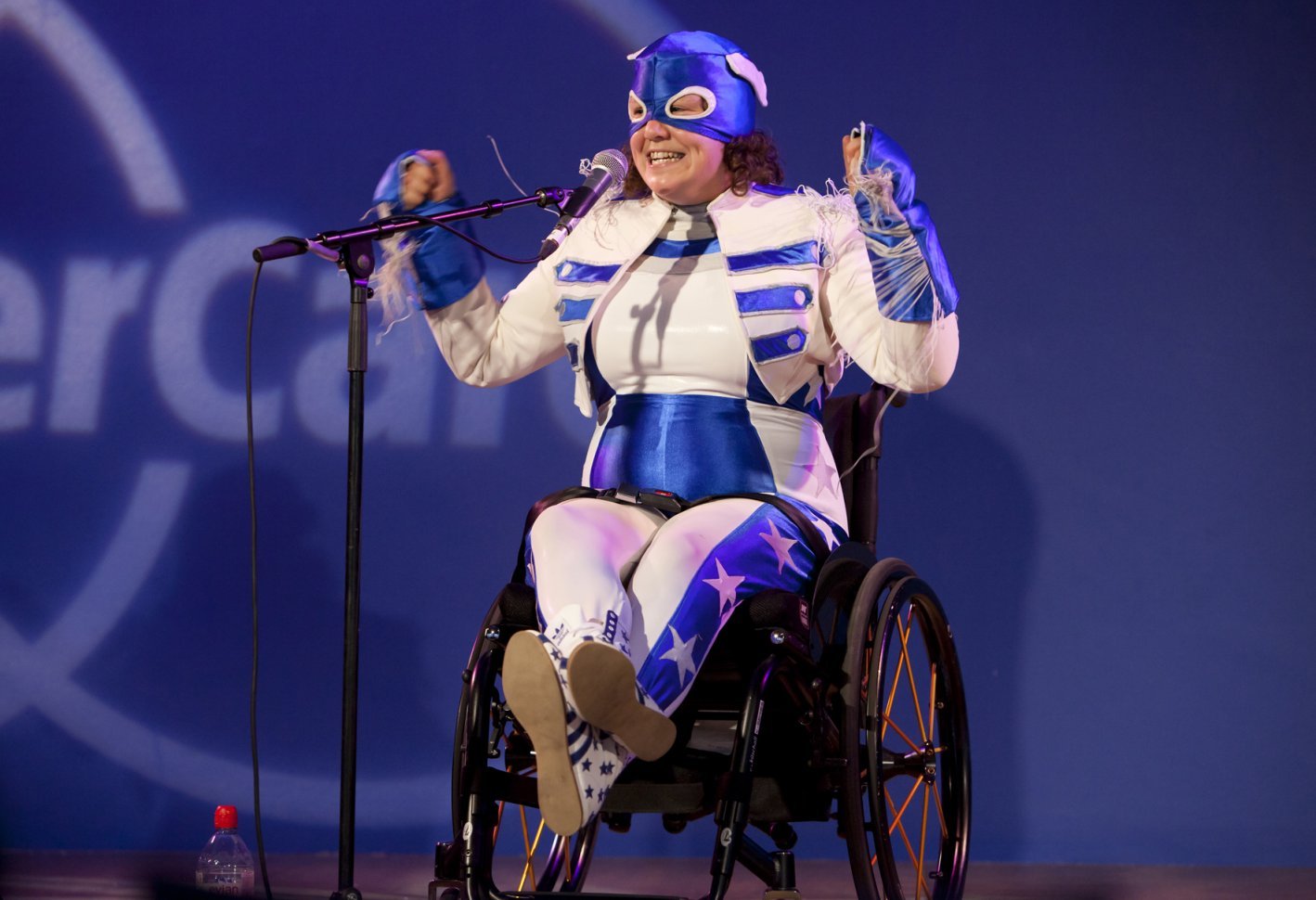
Touretteshero, aka Jessica Thom, performing at Southbank Centre's Unlimited Festival 2014
Photo: Rachel Cherry
Unlimited access
To make Southbank Centre’s Unlimited Festival a success, Wendy Martin knew that she had to improve accessibility for the 100 performers and artists with disabilities.
The Unlimited Festival at the Southbank Centre is one of 15 annual and biennial festivals created, produced and presented in-house, and is part of our year-round festival model. At the second Unlimited Festival in September this year, we presented over 20 performances and 11 installations, showcasing the work of over 100 international disabled performers, artists, activists and thinkers. Nearly 2,000 people bought tickets and an estimated 400,000 people visited the six-day festival.
When embarking on the Unlimited Festival for the first time as part of the Paralympic Games in 2012, we knew that to make it a success we had to seek guidance and partnership from within the disability arts community. We needed to understand its history, politics and, most importantly, what the community wanted from its own festival. We began by approaching leading figures such as Ruth Gould, Artistic Director of Liverpool’s DaDa Fest; Tony Heaton, CEO of disability arts organisation Shape; Jenny Sealey, Artistic Director of Graeae; and actor, writer and director Garry Robson.
I now appreciate the creative and theatrical possibilities of access devices such as sign language interpretation, audio description, captioning and speech to text
Unlimited Festival presented us with an opportunity to review the accessibility of our physical site, building on the access improvements made when the Royal Festival Hall and the surrounding public areas were transformed and reopened in 2007. We also reviewed performances, printed materials, web pages, directional signage and site navigation, as well as reviewing and developing practices, procedures and training across several departments such as marketing, visitor experience and event production. An access steering group was established, consisting of staff from across Southbank Centre. Partnerships were forged with external specialists to identify areas for improvement, including accessibility, and a consultant was engaged in the role of access coordinator. We also sought advice from wheelchair-users about the physical access front of house and in backstage areas in Queen Elizabeth Hall, and the Royal National Institute of Blind People advised us on our marketing materials. Our event managers, production managers and visitor services staff working on the festival undertook training in assisting those with a disability and providing information in the most accessible format. This training now forms part of the induction process for new staff.
The most challenging aspect when programming the festival was physical access. The Queen Elizabeth Hall, including the Purcell Room, were opened in 1967 – decades before access legislation was introduced in 2004. We have recently been successful in securing funding from Arts Council England and initial support from the Heritage Lottery Fund to repair and maintain this part of the site. Scheduled to begin in September 2015, the project will include improved access for both artists and audience. For the Unlimited Festivals in 2012 and 2014 we had to work hard to ensure that physical access was addressed as much as possible. The artists’ entrance to Queen Elizabeth Hall, which is at street level, was adopted as the main entrance to the building, and a temporary ramp into the Purcell Room, replacing stairs and a wheelchair lift, will remain in place until the building closes for refurbishment.
Our marketing team created our first fully accessible website, which supported other firsts such as a British Sign Language-signed welcome to the centre, a dedicated accessible map and accessible formats of the festival brochure including versions in large print, Braille and MP3 digital audio. We improved and increased signage and created an accessible visual identity of bold, black text on a yellow background. Accessible information points were created around the site and staffed by stewards who, in line with the visual identity of the festival, wore yellow T-shirts with ‘Here to help’ written in bold, black text.
One of our most important priorities was budgeting for access costs to enable disabled artists to present their work, and encouraging artists to make their shows as accessible as possible. As a programmer, I now appreciate the creative and theatrical possibilities of access devices such as sign language interpretation, audio description, captioning and speech to text. It is exciting to see artists asking questions about how these tools might be an agent for artistic innovation and to present work which has these elements fully embedded in the performance. Types of access provision in Unlimited Festival performances included British Sign Language (BSL) interpretation, audio description, captioning and pre-show touch tours. Talks and debates, including post-show discussions, were signed and live captioned, and workshops were supported by BSL interpreters. This access provision is now carried through in our year-round programme.
Several years in, we have been overwhelmed by the way in which audiences have embraced and welcomed the exuberant celebration that is the Unlimited Festival. It captures the essence of our core belief in the potential of art to change the way we see the world.
Wendy Martin is Head of Performance and Dance at the Southbank Centre.
www.southbankcentre.co.uk
Join the Discussion
You must be logged in to post a comment.